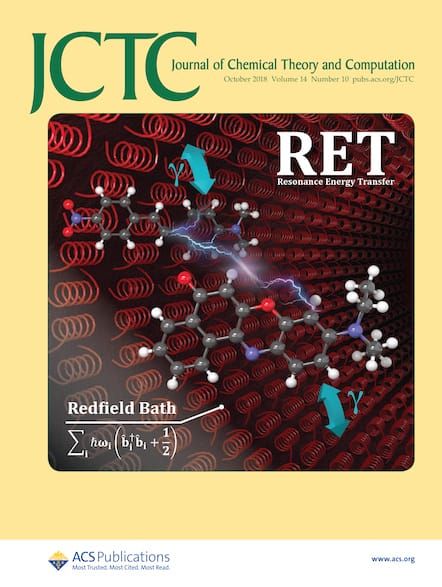Toward Reliable Conformational Energies of Amino Acids and Dipeptides─The DipCONFS Benchmark and DipCONL Datasets.
IF 5.7
1区 化学
Q2 CHEMISTRY, PHYSICAL
引用次数: 0
Abstract
Simulating peptides and proteins is becoming increasingly important, leading to a growing need for efficient computational methods. These are typically semiempirical quantum mechanical (SQM) methods, force fields (FFs), or machine-learned interatomic potentials (MLIPs), all of which require a large amount of accurate data for robust training and evaluation. To assess potential reference methods and complement the available data, we introduce two sets, DipCONFL and DipCONFS, which cover large parts of the conformational space of 17 amino acids and their 289 possible dipeptides in aqueous solution. The conformers were selected from the exhaustive PeptideCS dataset by Andris et al. [ J. Phys. Chem. B 2022, 126, 5949-5958]. The structures, originally generated with GFN2-xTB, were reoptimized using the accurate r2SCAN-3c density functional theory (DFT) composite method including the implicit CPCM water solvation model. The DipCONFS benchmark set contains 918 conformers and is one of the largest sets with highly accurate coupled cluster conformational energies so far. It is employed to evaluate various DFT and wave function theory (WFT) methods, especially regarding whether they are accurate enough to be used as reliable reference methods for larger datasets intended for training and testing more approximated SQM, FF, and MLIP methods. The results reveal that the originally provided BP86-D3(BJ)/DGauss-DZVP conformational energies are not sufficiently accurate. Among the DFT methods tested as an alternative reference level, the revDSD-PBEP86-D4 double hybrid performs best with a mean absolute error (MAD) of 0.2 kcal mol-1 compared with the PNO-LCCSD(T)-F12b reference. The very efficient r2SCAN-3c composite method also shows excellent results, with an MAD of 0.3 kcal mol-1, similar to the best-tested hybrid ωB97M-D4. With these findings, we compiled the large DipCONFL set, which includes over 29,000 realistic conformers in solution with reasonably accurate r2SCAN-3c reference conformational energies, gradients, and further properties potentially relevant for training MLIP methods. This set, also in comparison to DipCONFS, is used to assess the performance of various SQM, FF, and MLIP methods robustly and can complement training sets for those.实现氨基酸和二肽的可靠构象能--DipCONFS 基准和 DipCONL 数据集。
模拟多肽和蛋白质正变得越来越重要,因此对高效计算方法的需求也越来越大。这些方法通常是半经验量子力学(SQM)方法、力场(FF)或机器学习原子间位势(MLIP),所有这些方法都需要大量准确的数据来进行强大的训练和评估。为了评估潜在的参考方法并补充现有数据,我们引入了两组数据:DipCONFL 和 DipCONFS,它们涵盖了水溶液中 17 种氨基酸及其 289 种可能的二肽的大部分构象空间。这些构象是从 Andris 等人详尽的 PeptideCS 数据集中挑选出来的[J. Phys. Chem. B 2022, 126, 5949-5958]。最初使用 GFN2-xTB 生成的结构使用精确的 r2SCAN-3c 密度泛函理论(DFT)复合方法(包括隐式 CPCM 水溶解模型)进行了重新优化。DipCONFS 基准集包含 918 个构象,是迄今为止具有高精度耦合簇构象能的最大基准集之一。该基准集用于评估各种 DFT 和波函数理论 (WFT) 方法,特别是评估这些方法是否足够精确,可以作为更大数据集的可靠参考方法,用于训练和测试更近似的 SQM、FF 和 MLIP 方法。结果表明,最初提供的 BP86-D3(BJ)/DGauss-DZVP构象能量不够准确。在作为替代参考水平测试的 DFT 方法中,revDSD-PBEP86-D4 双混合方法表现最佳,与 PNO-LCCSD(T)-F12b 参考相比,平均绝对误差 (MAD) 为 0.2 kcal mol-1。非常高效的 r2SCAN-3c 复合方法也显示出优异的结果,其平均绝对误差为 0.3 kcal mol-1,与经过最佳测试的混合方法 ωB97M-D4 相似。有了这些发现,我们编制了大型 DipCONFL 数据集,其中包括超过 29,000 个溶液中的真实构象,这些构象具有相当精确的 r2SCAN-3c 参考构象能、梯度以及可能与 MLIP 方法训练相关的其他属性。与 DipCONFS 相比,该数据集还可用于评估各种 SQM、FF 和 MLIP 方法的性能,并可补充这些方法的训练集。
本文章由计算机程序翻译,如有差异,请以英文原文为准。
求助全文
约1分钟内获得全文
求助全文
来源期刊

Journal of Chemical Theory and Computation
化学-物理:原子、分子和化学物理
CiteScore
9.90
自引率
16.40%
发文量
568
审稿时长
1 months
期刊介绍:
The Journal of Chemical Theory and Computation invites new and original contributions with the understanding that, if accepted, they will not be published elsewhere. Papers reporting new theories, methodology, and/or important applications in quantum electronic structure, molecular dynamics, and statistical mechanics are appropriate for submission to this Journal. Specific topics include advances in or applications of ab initio quantum mechanics, density functional theory, design and properties of new materials, surface science, Monte Carlo simulations, solvation models, QM/MM calculations, biomolecular structure prediction, and molecular dynamics in the broadest sense including gas-phase dynamics, ab initio dynamics, biomolecular dynamics, and protein folding. The Journal does not consider papers that are straightforward applications of known methods including DFT and molecular dynamics. The Journal favors submissions that include advances in theory or methodology with applications to compelling problems.
 求助内容:
求助内容: 应助结果提醒方式:
应助结果提醒方式:


